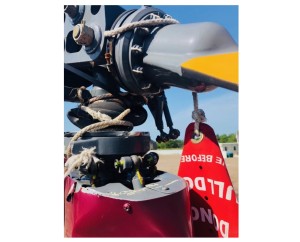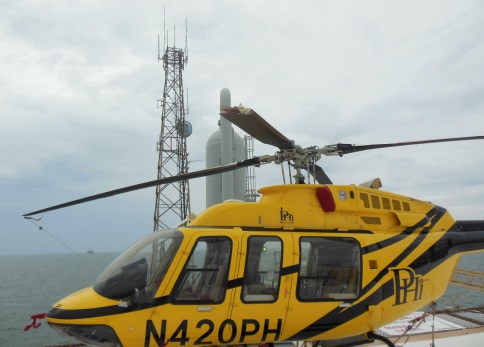Troublesome Tiedowns
The US National Transportation Safety Board (NTSB) has recently reported on two cases in October 2015 were helicopters offshore suffered accidents after the tie-downs were not fully removed:
Fish Spotting Helicopter, Pacific Ocean (B206, N1060C)
On 21 October 2015 Bell 206B N1060C was being prepared for take-off from the 74m Fishing Vessel Majestic Sun off Christmas Island, Kiribati in the Pacific for a fish spotting flight. The NTSB say:
The pilot of the helicopter reported that he entered the helicopter for takeoff while the mechanic removed the tie downs from the helicopter. The pilot reported that when he tried to takeoff, one of the [four] tie downs was still attached to the helicopter and the helicopter rolled to the right and impacted the helipad. The helicopter sustained substantial damage to the main rotor, mast, and tail boom.
In this case it appears that the tie downs were applied to the floats and were removed after the pilot boarded the helicopter (not unreasonable for operation on a small moving deck).
Oil and Gas Helicopter, Gulf of Mexico (PHI B407 N420PH)
On 30 October 2015, N420PH, a Bell 407 of PHI, lost most of one rotor blade in an accident on an offshore installation in the Gulf of Mexico (WC167).
…the pilot and aircraft began the operational day at High Island A 264, an offshore platform located in
the Gulf of Mexico. The pilot began his duty day at 06:25 CST. At 08:07 the aircraft departed the platform with the pilot and one passenger onboard destined for another offshore location, West Cameron 149 arriving at 08:41.The pilot dropped off his passenger and flew the aircraft with no passengers to another offshore location; West Cameron 167 arriving at 08:51 . The pilot shut down the aircraft and secured the main rotor system by attaching a rope to the forward left main rotor blade and tying the rope end to the left front skid cross tube. He then went inside the platform facility for slightly over 3 hours while waiting for a call to return to West Cameron 149 to pick up the passenger.
The pilot received a call at approximately 12:15 instruction him to return to West Cameron 149 to pick up the passenger for further transportation as directed. The pilot went to the platform helideck were the aircraft was located and proceeded directly to the right-rear cabin door and placed his personnel bag in the aircraft. He then moved to the right-front cockpit door and placed additional personnel items in the aircraft in preparation for flight, then entered the aircraft using the same door and sat in the right-front pilot seat.
He then proceed to start the aircraft and noted a few seconds after initiating the engine start the aircraft make an “unusual noise” and began to shake. He immediately secured the engine and completed aircraft shutdown. Upon exiting the aircraft he found one main rotor blade damaged by the rotation of the main rotor system with the tie down attached during the engine start.
The Bell Helicopter 407 Rotorcraft Flight Manual lists the preflight check areas in Section 2 Normal Procedures. Regarding the exterior check, this manual states in part;
2-3-B-1. Fuselage – Cabin Right Side
1. All main rotor blades – tiedowns removed, condition.
There is also a warning in this section that states, “Failure to remove rotor tiedowns before engine starting may result in severe damage and possible injury.”
Final Word
While in both these cases it became evident rapidly, and dramatically, that a tiedown remained attached, that is not always the case. On 9 April 2010 the NTSB report that a fatigued pilot of a US HEMS Bell 222 N222UT left a tail rotor tiedown attached (having ‘assumed’ that the flight nurse had removed it). This resulted in damage to a tail rotor blade and all of the pitch change links. Also noteworthy (and perhaps a further indication of fatigue) is that while the damage was spotted when picking up the patient, the return flight was still made.
- The adequacy of pre-flight inspections was a factor in these previous occurrences we have discussed:
At least 10 years ago there was a deck tie-down occurrence involving a Enstrom 480B, reportedly on a Greenpeace vessel off Ireland:
Deck nets are normally not used with skid equipped helicopters because of the snagging hazard.
UPDATE 7 November 2017: Video of an H500 tie down accident is posted on line.
UPDATE 20 February 2018: BSEE, the US offshore regulator, publishes Safety Bulletin 010 “Complacency in Aviation is Everyone’s Challenge” that discusses a flight requested to wrong offshore location, take off with tie downs still installed and walking past a tail rotor.
UPDATE 11 March 2018: EC120 Forgotten Walkaround
UPDATE 10 June 2019: Troublesome Tiedowns: The Sequel A Robinson R22 suddenly fails to respond to control inputs and descends and impacts the sea. Investigators find a tie-down wrapped around the main rotor head.

Tie Down and ‘Remove Before Flight’ Streamer Wrapped Around R22 N923SM Main Rotor Head (Credit: NTSB)
We have previously written:



Recent Comments